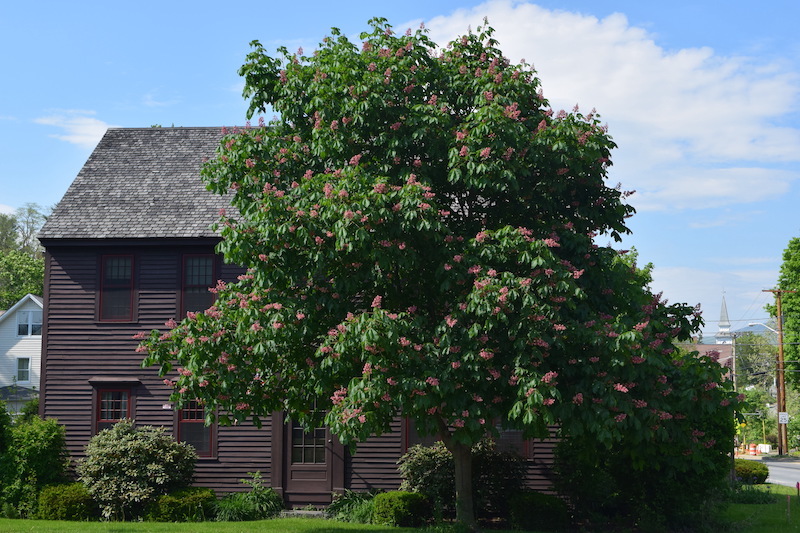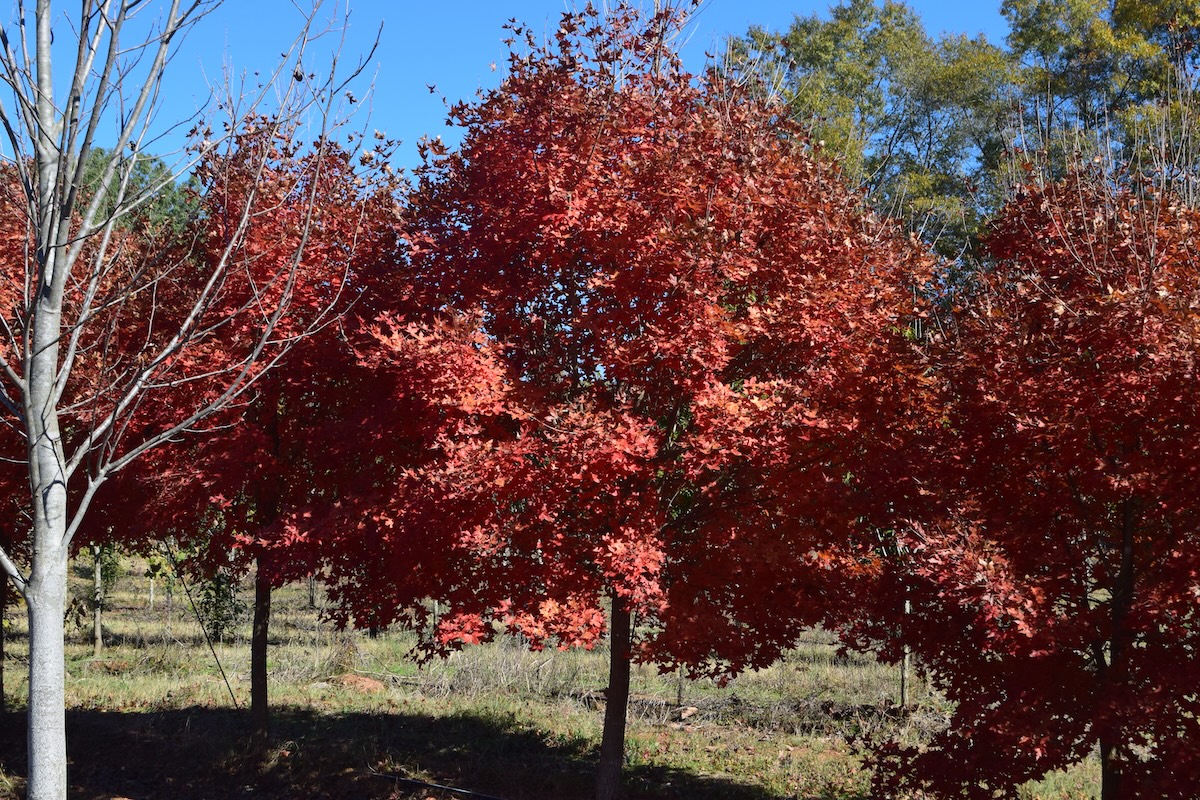Aesculus, the buckeyes and horse chestnuts, comprise 13-19 species in the United States, Europe and Asia. Aesculus arguta, Texas buckeye, A. flava, yellow buckeye, A. glabra, Ohio buckeye, A. parviflora, bottlebrush buckeye, A. pavia, red buckeye, and A. sylvatica, painted buckeye, are reasonably well represented, at least in botanical gardens and arboreta from Minnesota to Georgia. Many of these species interbreed and hybrids are known. Aesculus californica, California buckeye, is a beautiful, white-flowered, broad-canopied tree found on dry hillsides in California. It is seldom cultivated in the eastern U.S., although pretty specimens are extant at the JC Raulston Arboretum, Raleigh, NC, and the Norfolk Botanical Garden, VA. The fruits/seeds are the largest of the U.S. species. I have grown and/or propagated all the eastern species, with A. flava, A. parviflora, and A. pavia sprinkled throughout our 3.5 acres, primarily in shady habitats.

Flowering Aesculus x carnea
The rarest species in the garden are A. chinensis, Chinese horse chestnut, which has yet to flower, and A. ×carnea, red horse chestnut, which flowered consistently the past 10 years, although considered ill-suited to the southeast. The tree was planted in 2013 and is now 15’ high and 12’ wide. Sited in full sun (by definition at least 6-hours), but on the north side of larger pines and oaks, it exceeded expectations. It is the result of hybridization between A. hippocastanum, common or European horse chestnut, and A. pavia, red buckeye. The hybrid is thought to have arisen in Germany as a spontaneous seedling. This means that the two parents were in proximity and the unscheduled wedding occurred, resulting in this magnificent, lustrous dark green leaved, rose-red-flowered, stately, medium-sized tree. I notice variation in the intensity of red flower coloration, so seedling trees, although purported to breed true-to-type, do not necessarily do so. I have collected seeds of the species but have yet to have a seedling flower. Aesculus flava seedlings produce flowers in their second and third years. To minimize thievery by squirrels, the fruits are collected when the outer, light brown, leathery husk starts to split. The seeds of A. ×carnea are polished brown-black and ¾ to 1-inch diameter. Seeds are planted immediately, covered with wire/netting to protect from varmints. Seedlings develop a taproot soon after planting; the shoot appearing immediately or the following spring.

Aesculus x carnea bark
In England and the European continent, the species is common, with mature trees hovering between 40 to 50’ high and wide. The red flower color is more intense there, possibly because of the cooler day/night temperatures. The largest trees in the U.S. are found in the northern states, not quite as prosperous/large in Zone 8, yet quite respectable. My wife and I host visitors/tours in May, and the A. ×carnea ‘Briotii’ (see under cultivars) is the most asked about plant. What is it and where can I buy one?
Aesculus ×carnea and A. hippocastanum are often maligned because of the leaf blotch (Guignardia aesculi/Phyllosticta sphaeopsoidea) which causes brown, disfigured, and tatty leaves in summer-fall. The disease does not kill the trees. I have found that A. ×carnea is less susceptible and, based on the 10 years in our garden, worthy of greater use from zone (4)5 to 8a. The Dirr tree is minimally affected by the blotch with leaves persisting into November. In Salt Lake City, UT, during an October visit, I noticed A. ×carnea and A. hippocastanum mixed in a street tree planting. The former clean; the latter riddled with leaf blotch.

Aesculus x carnea fruit
The rose-red flowers are borne in 6 to 8” long, 3 to 4” wide terminal panicles in May. The tree flowers in late April into early May in Athens; a month later in the Boston area. The lustrous dark green, compound palmate leaves are composed of 5(7), 3 to 6” long leaflets, each with a slight undulating surface and serrated margins. Leaves may develop a tinge of yellow in fall. The buds, especially the flower (terminal), are ½ to ¾” long, and covered with dark chestnut brown, sticky scales. The stems are stout, gray; young trunks smooth and gray-brown; older becoming scaly and darker brown. The fruit covering has short spines, somewhere between the spiny fruit of A. hippocastanum and the smooth fruit of A. pavia.
The species is best adapted to moist, well-drained, acid or neutral soil, full sun to partial shade. Container and balled and burlapped trees transplant readily. Although the literature refers to lack of heat and drought tolerance, I have yet to observe leaf drop/browning.
Cultivars:

Aesculus x carnea Briotii flower
'Briotii’, known as the ruby red horse chestnut, is commercially available. It originated from seed in 1858 at the Trianon in France. Flowers are deeper red and borne on 10” long inflorescences. I encountered many trees labeled as ‘Briotii’ and the flower colors do not always match the description. The tree in our garden was purchased as ‘Briotii’ yet the flower color is pink-rose rather than red. Ideally purchase the tree in flower. I speculate that other A. ×carnea seedlings may have been labeled as such.

Aesculus x carnea Fort McNair
‘Fort McNair’ was selected for the increased resistance to leaf blotch. In Athens, I see little difference in susceptibility between this and ‘Briotii’. Certainly, a handsome tree and, without the label, I could not tell it from the Dirr ‘Briotii’. Selected on the grounds of Fort McNair, Washington, DC.
‘O’Neil’s Red’ has longer inflorescences (to 12”) and brighter red flowers than the above. A particularly beautiful tree grew in the Sarah P. Duke Gardens, Durham, NC, and flowered there in early to mid-May. Many spellings of the cultivar name. A reference mentioned ‘O’Neill Red’ was introduced by Monrovia Nursery circa 1979.
I believe an opportunity exists for intelligent/transformational breeding with Aesculus. The New World, A. pavia, serendipitously crossed with the Old World, A. hippocastanum; thus, other far-fetched species’ combinations may be possible. Hybrids of the eastern North American species like A. flava, A. glabra, A. pavia, and A. sylvatica are common and legitimized by GRIN taxonomy (see www.ars-grin.gov). Hybrids between A. parviflora and A. pavia would result in superb, pink-flowered offspring. I need to get back to the work at the breeding bench.





